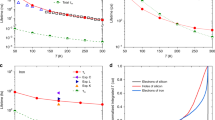Abstract
In NMR experiments performed on metals at low temperatures, the analysis to obtain the nuclear spin-lattice relaxation time τ1 can be quite complicated. The electronic heat capacity ultimately becomes less than that of the nuclear spins, and the characteristic times for heat flow through the various resistances between the nuclear spins and the thermal bath can become long relative to τ1. This makes it necessary to solve the full set of coupled differential equations describing the thermal relaxation. This problem has been examined because τ1 is used as a thermometric parameter, and we consider the cases when the radiofrequency field penetrates the sample completely (powders and foils) and when only the skin-depth nuclei are excited (bulk specimens). Using our theoretical model, we analyze experimental results for platinum powder and a thallium bulk sample and obtain consistent values for κ=τ1 T over a wide range of experimental conditions, even when thermal bottlenecks occur and the apparent relaxation time is much longer than τ1. These values are κ(Pt)=(34.2±0.6)×10−3 sec K and κ(Tl)=(4.37±0.08)×10−3 sec K.
Similar content being viewed by others
References
A. Abragam,Principles of Nuclear Magnetism (Oxford University Press, Oxford, 1961).
J. Korringa,Physica 16, 601 (1950).
R. Ling, E. R. Dobbs, and J. Saunders,Phys. Rev. B 33, 629 (1986).
F. Pobell, private communication.
O. Avenel, P. M. Berglund, and E. Varoquaux, unpublished; see ref. 3
M. Veuso,Acta Polytech. Scand. 122, 7 (1978).
C. Kittel,Phys. Rev. 104, 1807 (1956).
R. L. Peterson,Phys. Rev. 137, A1444 (1965).
J. P. Harrison,J. Low Temp. Phys. 37, 467 (1979).
A. Abragam and B. Bleaney,Electron Paramagnetic Resonance of Transition Ions (Clarendon Press, Oxford, 1970).
W. R. Smythe,Static and Dynamic Electricity (McGraw-Hill, New York, 1939).
D. D. Osheroff and R. C. Richardson, inProceedings of the 17th International Conference on Low Temperature Physics (North-Holland, Amsterdam, 1984), p. 751.
T. Perry, K. De Conde, J. A. Sauls, and D. L. Stein,Phys. Rev. Lett. 48, 1831 (1982).
A. C. Anderson, J. I. Connolly, O. E. Vilches, and J. C. Wheatley,Phys. Rev. 147, 86 (1966).
W. R. Abel, R. T. Johnson, J. C. Wheatley, and W. Zimmermann,Phys. Rev. Lett. 18, 737 (1967).
G. Eska, E. Schuberth, and B. Turrell,Phys. Lett. A 115, 413 (1986).
L. E. Drain,J. Phys. Chem. Solids 24, 379 (1963).
U. Angerer and G. Eska,Cryogenics 24, 521 (1984).
G. Eska and E. Schuberth, to be published.
Author information
Authors and Affiliations
Additional information
On leave from Department of Physics, University of British Columbia, Vancouver, British Columbia, Canada.
Rights and permissions
About this article
Cite this article
Turrell, B.G., Eska, G., Masuhara, N. et al. Nuclear spin-lattice relaxation in metals at low temperatures. J Low Temp Phys 70, 151–172 (1988). https://doi.org/10.1007/BF00683249
Received:
Issue Date:
DOI: https://doi.org/10.1007/BF00683249




